One Design, Two Products: The SanDisk Ultra 3D (1TB) and WD Blue 3D (1TB) SSD Reviews, with BiCS 3D NAND
by Billy Tallis on September 14, 2017 9:00 AM ESTAnandTech Storage Bench - Heavy
Our Heavy storage benchmark is proportionally more write-heavy than The Destroyer, but much shorter overall. The total writes in the Heavy test aren't enough to fill the drive, so performance never drops down to steady state. This test is far more representative of a power user's day to day usage, and is heavily influenced by the drive's peak performance. The Heavy workload test details can be found here. This test is run twice, once on a freshly erased drive and once after filling the drive with sequential writes.
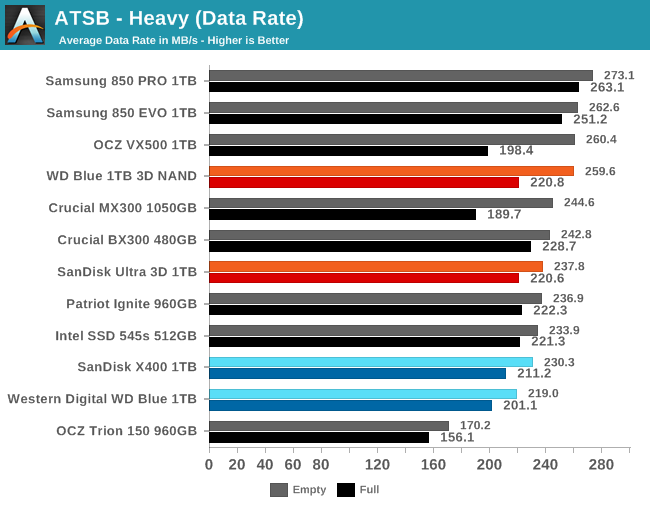
Orange is for the new drives, Blue is for the previous generation models
The new WD and SanDisk SSDs offer improved average data rates on the Heavy test. Their peak performance when the test is run on an empty drive rivals Samsung's 850 EVO, but Samsung still has the clear advantage in performance consistency with the best performance on a full drive.
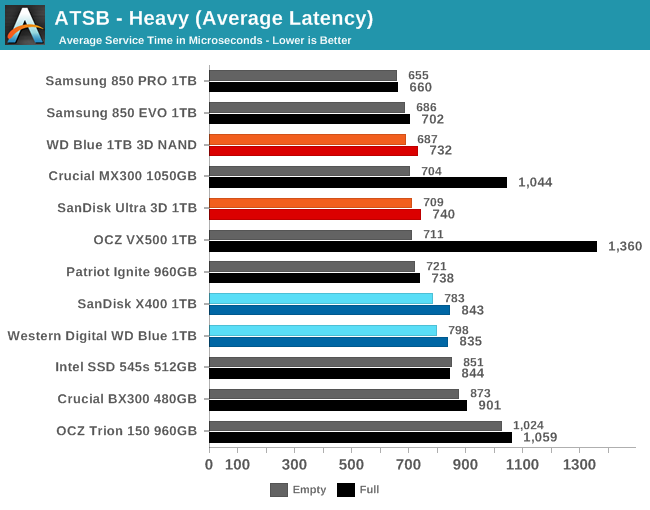

Average and 99th percentile latencies are both improved, placing the new WD and SanDisk SSDs in the top performance tier for SATA drives. The 99th percentile latency results in particular show improved handling of a full drive.
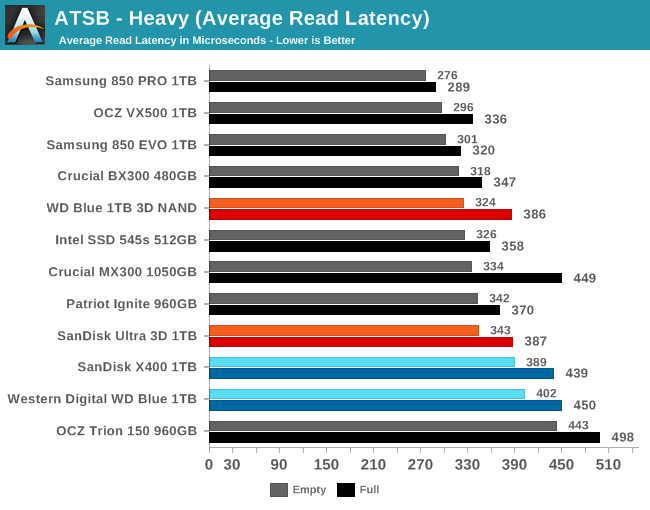
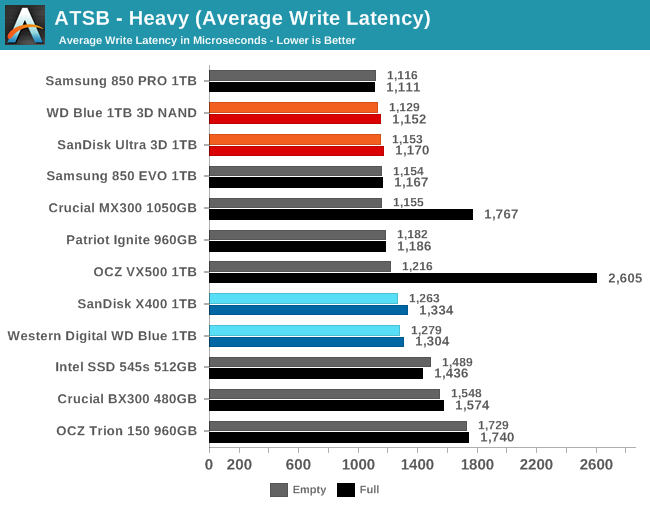
Average read and write latencies on the Heavy test have both been reduced by more than 10%, putting the new Western Digital SSDs on par with their modern 3D NAND competitors.
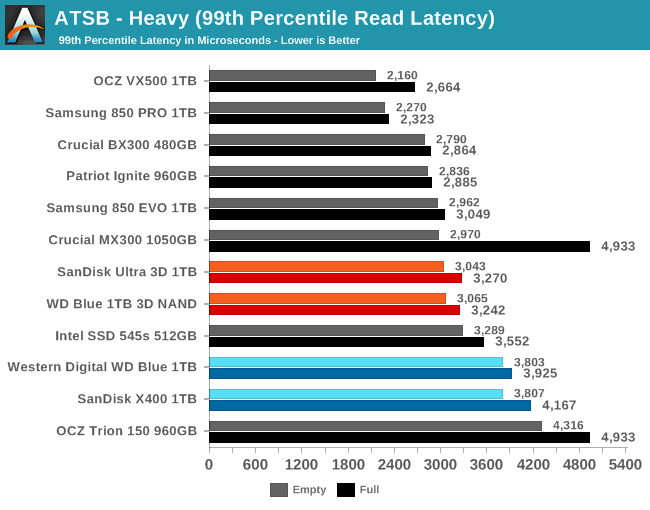
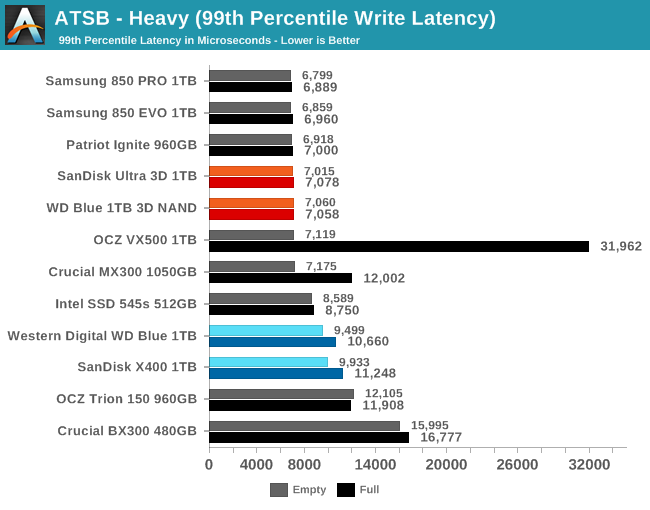
The 99th percentile read and write latencies show even larger improvement than the averages, with reductions of more than 20% for the WD and SanDisk 3D NAND drives compared to the preceding planar TLC drives. The 99th percentile write latency is now in the top tier, but the 99th percentile read latency has merely improved to average as the MLC SSDs all beat the TLC SSDs on that metric.
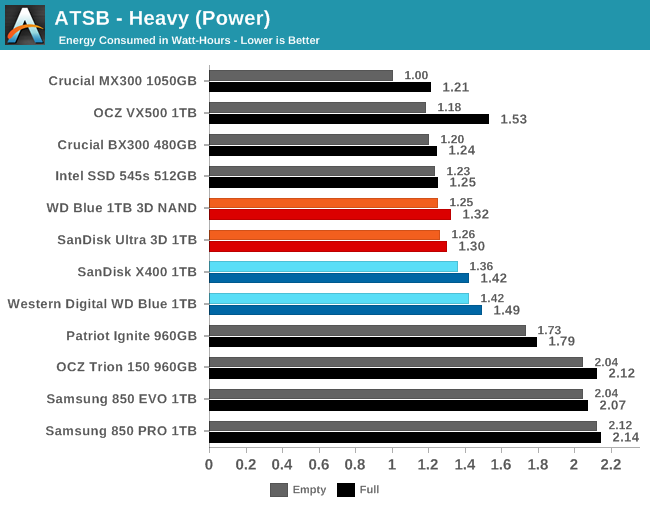
Energy efficiency on the Heavy test has clearly improved with Western Digital's switch to 3D NAND, but the Intel/Micron SSDs still come out ahead, and even the Toshiba OCZ VX500 with planar MLC is more efficient so long as the test is run on an empty drive.










52 Comments
View All Comments
MajGenRelativity - Thursday, September 14, 2017 - link
Looks like a good drive to keep in mind. Congratulations to WD and SanDisk on making a product worthy of challenging the 850 Evo. Good to see the rest of the market FINALLY catching up!nathanddrews - Thursday, September 14, 2017 - link
Knowing that SATA is just about completely tapped at this point, it would just be nice if we could get these drives down to the $0.10/GB range.MajGenRelativity - Thursday, September 14, 2017 - link
Unfortunately, that won't happen while we're in the middle of a NAND shortage/price fixing epidemicDanNeely - Thursday, September 14, 2017 - link
Agreed. I'm hoping that by next year the large scale switch over from planar to 3d nand will be complete and the supply situation will be less squeezed.MajGenRelativity - Thursday, September 14, 2017 - link
Yep. I hope DRAM prices go down tooDanNeely - Thursday, September 14, 2017 - link
Same, although a shortage caused by rising demand is at least a good problem to have after years of the consumer PCs decline dragging the industry down.MajGenRelativity - Thursday, September 14, 2017 - link
That's true, assuming the "shortage" is caused by rising demand. I have no proof either way, so you quite well could be right.melgross - Wednesday, September 20, 2017 - link
Much of it is coming from increasing smartphone and tablet storage. For example, Apple now has either 64GB or 256GB for their phones, and up to 512GB for the Pro tablets. Those are pretty large numbers, and along with some Android models, are sucking a lot of NAND and RAM out of the market.smilingcrow - Thursday, September 14, 2017 - link
The demand is coming from other areas not PCs and that's only half of it.The other is that they have kept supply low so not to get into the same over supply issue that they have had before.
The very low RAM prices were unsustainable due to massive losses but not sure if NAND has ever been sold below cost.
MajGenRelativity - Thursday, September 14, 2017 - link
Ah